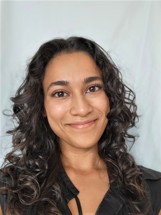Introducing the 2022 Student Researcher Travel Grant Recipients
The IADMS Research Committee is proud to announce the four recipients of this year's Student Researcher Travel Grants! Student research abstracts for the IADMS 32nd Annual Conference were blind reviewed by the Research Committee, evaluating multiple criteria, from methodological merit to originality. All of the recipients have demonstrated outstanding and promising work, and we celebrate them for their accomplishments!
In this blog post, we introduce the four Student Researcher Travel Grant recipients and learn more about their research and what receiving the award means to them! Be sure to check out part 1, where we introduce the two student research award recipients.
Aalaya Milne
Title: Penis points to standards of whiteness: dancers’ social identities and experiences of harm
Co-Authors: Ashley Stirling
Presentation: Sunday October 30, 10:45-11:00 am (GMT+1)
Award generously supported by the Harkness Center for Dance Injuries
 The purpose of my research was to explore competitive dancers’ experiences of harm in the dance environment with a focus placed on the dancers’ social identities.While the majority of the competitive dance population is comprised of affluent White women, many popular dance genres are founded in dance forms created by Black, Latin, and LGBTQ+ communities (Schupp, 2020) creating systems of power imbalances based on social identity. Upon receiving consent from participants, semi-structured interviews were conducted with 24 competitive dancers of various gender identities, racial identities, and sexual orientations. Several themes were generated including Whiteness as the standard, higher value of boys in dancers, impact of socio-economic status, sexualization of young females, and fear of the “predatory” lesbian. Competitive dancers reported that their social identities impacted their dance experience and at times influenced their opportunities to be showcased in choreography as well their instructor-dancer relationship.
The purpose of my research was to explore competitive dancers’ experiences of harm in the dance environment with a focus placed on the dancers’ social identities.While the majority of the competitive dance population is comprised of affluent White women, many popular dance genres are founded in dance forms created by Black, Latin, and LGBTQ+ communities (Schupp, 2020) creating systems of power imbalances based on social identity. Upon receiving consent from participants, semi-structured interviews were conducted with 24 competitive dancers of various gender identities, racial identities, and sexual orientations. Several themes were generated including Whiteness as the standard, higher value of boys in dancers, impact of socio-economic status, sexualization of young females, and fear of the “predatory” lesbian. Competitive dancers reported that their social identities impacted their dance experience and at times influenced their opportunities to be showcased in choreography as well their instructor-dancer relationship.
I am incredibly honored to have received a student research award. With this award, I am able to continue to conduct research in the area knowing that it can impact the dance community. I’m very grateful for the opportunity to present this research at the conference with so many dance educators and researchers and a community that supports emerging researchers. Thank you!
Allysan Lui
Title: Validity of the High Intensity Dance Performance Fitness Test in Undergraduate Contemporary Dancers
Co-Authors: Jesse Oswald, John Holash
Poster Presentation: Saturday October 29, 5:00-6:00 pm (GMT+1)
Award generously supported by the Harkness Center for Dance Injuries
 The high intensity dance performance fitness test (DAFT2) was the first validated dance-specific exercise method designed to measure cardiovascular fitness in professional contemporary dancers. The test consists of movement representative of contemporary dance and an exercise to rest ratio that mimics the intermittent nature of dance. The purpose of the present study is to validate the DAFT2 in an undergraduate contemporary dance population. Participants performed the DAFT2 protocol four times, with continuous heart rate (HR), ratings of perceived exertion (RPE), and blood lactate (BLa) taken after each trial. Participants also performed a V̇O2max test on a treadmill; with HR, RPE, BLa, and expired ventilatory gasses recorded continuously. Among this population, the DAFT2 produced lower HR, BLa, and RPE than maximal values from the treadmill test. In each successive DAFT2 trial, the population spent progressively more time above their second ventilatory thresholds indicating increasing cardiovascular demands. The DAFT2 effectively worked dancers at intensities relative to their second ventilatory threshold, stressed the participants’ aerobic system, and did not allow for full recovery during the 2-minute breaks. This study concludes that the DAFT2 is a valid tool for working undergraduate contemporary dancers at high intensity.
The high intensity dance performance fitness test (DAFT2) was the first validated dance-specific exercise method designed to measure cardiovascular fitness in professional contemporary dancers. The test consists of movement representative of contemporary dance and an exercise to rest ratio that mimics the intermittent nature of dance. The purpose of the present study is to validate the DAFT2 in an undergraduate contemporary dance population. Participants performed the DAFT2 protocol four times, with continuous heart rate (HR), ratings of perceived exertion (RPE), and blood lactate (BLa) taken after each trial. Participants also performed a V̇O2max test on a treadmill; with HR, RPE, BLa, and expired ventilatory gasses recorded continuously. Among this population, the DAFT2 produced lower HR, BLa, and RPE than maximal values from the treadmill test. In each successive DAFT2 trial, the population spent progressively more time above their second ventilatory thresholds indicating increasing cardiovascular demands. The DAFT2 effectively worked dancers at intensities relative to their second ventilatory threshold, stressed the participants’ aerobic system, and did not allow for full recovery during the 2-minute breaks. This study concludes that the DAFT2 is a valid tool for working undergraduate contemporary dancers at high intensity.
I am honoured to have been awarded a 2022 Student Research Award. By traveling to Ireland to attend and present at IADMS, I am investing in my education and future career. I am so grateful to have this investment supported by the IADMS award committee that recognized great potential in me and my research. As I conclude my undergraduate program this year, this award has helped me to feel more empowered and confident in my abilities as I pursue the next steps in my professional career as a physiotherapist and researcher.
Chloe Hillyar
Title: Including The Maternal Body In Dance
Presentation: Sunday October 30, 11:30-11:45 pm (GMT+1)
Award generously supported by an anonymous donor
 The research illustrated in the extended abstract is the first study phase (SP1) of a wider, ongoing PhD project. The primary aim of SP1 was to document what factors inhibit or exclude the participation of freelance pregnant and postpartum dancers. The primary aim of the wider PhD project is to produce a best practice charter that defines an upper-safe limit of physical activity to optimise professional opportunities for freelance pregnant and parent dancers working in the UK and Ireland dance sectors. The data collected in SP1 revealed that the UK and Ireland dance sectors are currently not conducive for pregnancy or parenthood. Due to the freelance nature of self-employed work, there is no standardised approach to managing pregnant or postpartum dancers. This means that many postpartum dancers return to work on the grounds of financial necessity which subsequently risks sustaining long-term injuries due to an insufficient postnatal recovery. To remedy this, most participants recommended: (1) flexible and individualized maternity policies that account for the health discrepancies between postpartum recoveries (as opposed to a “one-size-fits-all” approach); (2) pay that reflects the high cost of childcare to ensure dancing continues to be as financially viable for parents as it is for non-parents.
The research illustrated in the extended abstract is the first study phase (SP1) of a wider, ongoing PhD project. The primary aim of SP1 was to document what factors inhibit or exclude the participation of freelance pregnant and postpartum dancers. The primary aim of the wider PhD project is to produce a best practice charter that defines an upper-safe limit of physical activity to optimise professional opportunities for freelance pregnant and parent dancers working in the UK and Ireland dance sectors. The data collected in SP1 revealed that the UK and Ireland dance sectors are currently not conducive for pregnancy or parenthood. Due to the freelance nature of self-employed work, there is no standardised approach to managing pregnant or postpartum dancers. This means that many postpartum dancers return to work on the grounds of financial necessity which subsequently risks sustaining long-term injuries due to an insufficient postnatal recovery. To remedy this, most participants recommended: (1) flexible and individualized maternity policies that account for the health discrepancies between postpartum recoveries (as opposed to a “one-size-fits-all” approach); (2) pay that reflects the high cost of childcare to ensure dancing continues to be as financially viable for parents as it is for non-parents.
Receiving the student research award means that pregnancy and parenthood in dance is recognised as a worthy and topical subject area. As such, there is hope that conditions for parents will improve and we can expect to see more representation of pregnant, parent and mature dancers enjoying long and sustainable careers. The award contributes to diffusing the stigma around pregnancy and correcting the imbalance of childcare responsibilities that disproportionately impacts mothers; it foreshadows future investigations and potential financial investment. Ultimately, the accolade means that not only is pregnancy and parenthood a personal priority, but also an academic one.
Kato Everaert
Title: Low back pain perceptions and coping strategies in pre-professional dancers
Co-Authors: Amandine Blackman, Timothee Cayrol, Pascal Gielen, Kieran O’Sullivan, Eric Van Breda, Nathalie Roussel
Poster Presentation: Saturday October 29, 5:00-6:00 pm (GMT+1)
Award generously supported by an anonymous donor
 Kato Everaert is a PhD researcher at the University of Antwerp for the Department of Rehabilitation Science and Physiotherapy. Her research focuses on the elucidation of psychological and social risk factors for low back pain in (pre-)professional dancers. By means of qualitative research methodologies, she investigated what dancers describe as the main reason that causes their low back pain and how they cope with their low back pain episodes. As a result, dancers indicated mainly biological factors only when asking the question “what do you think is the main cause of your low back pain”. When focusing on the coping strategies, dancers preferred mainly the use of stretching techniques as coping strategy when suffering from low back pain.
Kato Everaert is a PhD researcher at the University of Antwerp for the Department of Rehabilitation Science and Physiotherapy. Her research focuses on the elucidation of psychological and social risk factors for low back pain in (pre-)professional dancers. By means of qualitative research methodologies, she investigated what dancers describe as the main reason that causes their low back pain and how they cope with their low back pain episodes. As a result, dancers indicated mainly biological factors only when asking the question “what do you think is the main cause of your low back pain”. When focusing on the coping strategies, dancers preferred mainly the use of stretching techniques as coping strategy when suffering from low back pain.
I am very honored and grateful to receive the student research award. This award will help me further investigate the psychological and social context of the (pre-) professional dancer in an international and interdisciplinary context. Additionally, it gives me the opportunity to further elaborate the dancers’ own opinion and vision more in depth, in relation to low back pain.